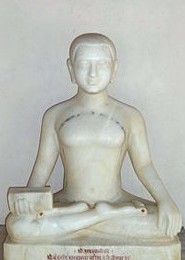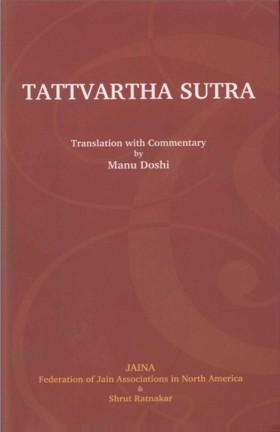03.12 Dwirdhātakikhande
Audio: Sanskrit: द्विर्धातकीखण्डे ।
Hindi: धातकीखण्ड में पर्वत तथा क्षेत्र जम्बूद्वीप से दुगने है।
03.13 Pushkarārdhe Cha
Audio: Sanskrit: पुष्करार्धे च ।
Hindi: पुष्करार्धद्वीप में भी उतने (धातकीखण्ड जितने) हैं ।
03.14 Prāk Mānushottarān Manushyāh
Audio: Sanskrit: प्राङ्मानुषोत्तरान् मनुष्या ।
Hindi: मानुषोत्तर नामक पर्वत के पहले तक (इस ओर) ही मनुष्य हैं।
03.15 Aryā Mīechchhashcha
Audio: Sanskrit: आर्या म्लेच्छाश्च ।
Hindi: मनुष्य आर्य एवं म्लेच्छ हैं।
03.16 Bharatairāvatvidehāh Karmabhoomayo'nyatra Devkuroottarkurubhyah
Audio: Sanskrit: भरतैरावतविदेहा: कर्मभूमयोsन्यत्र देवकुरूत्तकुरुभ्य: ।
Hindi: देवकुरु और उत्तरकुरु को छोड़ भरत, ऐरावत तथा विदेह - ये सभी कर्मभूमियाँ है।
03.12-16
English: There are double the continents in Dhatakikhand as well as in half of Pushkarvardweep. Humans live up to Manushottar Parvat. They are Aryans as well as Mlechchha. Bharat, Airāvat and Videh are Karmabhoomi.) Jamboodweep is surrounded by a ring-shaped salty sea called Lavansamudra. That is twice the size of Jamboodweep. That sea is surrounded by a ring-shaped mass of land called Dhatakikhand. That is twice the size of Lavansamudra. Dhatakikhand is surrounded by a ring-shaped sea called Kālodadhi, which is twice the size of Dhatakikhand. Kālodadhi is surrounded by a ring-shaped mass of land called Pushkarvardweep, which is twice the size of Kālodadhi and so on. Dhatakikhand is thus four times the size of Jamboodweep and Pushkarvardweep is sixteen times.
There are 56 islands within Lavansamudra and they are known as Antardweep. Dhatakikhand is divided in two equal parts by two bow shaped mountains running from north to south. Each of those halves contains the continents, mountains and rivers bearing the same names as those in Jamboodweep. There is a mountain range running across the entire width of Pushkarvardweep. That divides it into two parts, the part facing Kālodadhi is considered the inner part and the other one the outer part. The inner part contains as many continents and mountains as Dhatakikhand. The said mountain range covers the outer part like a fortress and is known as Mānushottar Parvat meaning the mountain that limits the human habitation. The human beings are not born beyond that barrier. Human habitation is thus restricted to Jamboodweep, Dhatakikhand and inner half of Pushkarvardweep. Those two and a half landmasses are collectively known as Adheedweep (See figure 3). The human beings residing there are either Aryans or MIechchhas.
Madhyalok does not end with Pushkarvardweep. That Dweep is surrounded by the Pushkar sea, which is surrounded by Varunvardweep and Varunvar sea, which is again surrounded by Ksheerdweep and Ksheersamudra (The milky sea; the bathing ceremony of a newly born Tirthankar is performed with milky liquid brought from it). Beyond the milky sea also there are many more masses of land and sea alternating one another, each of them being ring shaped and having twice the size of the preceding ring. The last land mass is called Swayambhooramandweep, which is surrounded by the Swayambhooraman sea.
As mentioned above, there are two sets of seven continents and six mountain ranges in Dhatakikhand, bearing the same names as those in Jamboodweep. Similarly, there are other two sets in inner half of Pushkarvardweep. Thus there are, in all, five sets of Bharat, Haimvat, Hari, Videh, Ramyak, Hairanyavat and Airāvat. Of these 35 continents, Sutra 16 states that five Bharats, five Airāvats and five Mahāvidehs (exclusive of Devkuru and Uttarkuru) are Karmabhoomis. It means the lands where the people have to work for their livelihood. All other areas constitute Akarmabhoomis, where the livelihood is derived from the bounties of nature. The inhabitants of those areas invariably go to the celestial abodes at the end of their life. Tirthankars are born only in Karmabhoomis.
MOUNTAIN MERU
In the exact center of Jamboodweep lies the mountain Meru. It has an altitude of 100,000 Yojans. Its lower end touches the upper level of infernal abode and the upper tip touches the bottom level of celestial abode. It is divided into three parts known as Kānds. The first Kānd is of 1000 Yojans lying within the ground and constitutes its base. It has the diameter of 10,000 Yojans and it mainly consists of earth. The next 63,000 Yojans constitute the second Kānd, which mainly consists of silver and crystals. The remaining 36,000 Yojans constitute the third Kānd, which mainly consists of gold. The diameter of Meru goes on decreasing at the higher altitudes till it remains 1000 Yojans at the top. On the top there is a 40 Yojan high Chulikā (cone-shaped tip) with a diameter of 12 Yojans at the base, 8 Yojans in the middle and 4 Yojans at the upper end.
This mountain is inaccessible to the laymen. On its side there are four huge parks known as Bhadrashāl, Nandan, Saumanas and Pāndakvan. Bhadrashāl is at the surface level of Jamboodweep, Nandanvan is spread from 500 Yojans to 1000 Yojans up, Saumanas is 63000 Yojans up and Pāndakvan is at the top of the mountain. There are thrones on all the four sides of Pāndakvan, where bathing ceremony is performed for the Tirthankar born in the respective direction of Meru.
BHARAT KSHETRA
Bharatkshetra lies on the extreme south of Jamboodweep. It is bounded by Himvān mountain range in the north and Lavan Samudra on the remaining three sides. That Kshetra itself is the Indo-Gangetic plain. Jain concepts of that area, however, differ from the geographical details in several respects. It is considered to have a crescent shape. Its east-west length is given as 14401— Yojans and north-south distance as 526-1- Yojans, which is l/190th part of the diameter of Jamboodweep. In the center of Bharat Kshetra lies the mountain Vaiīādhya extending from east to west and dividing the Kshetra into north and south.
Sindhu and Gangā are two major rivers of Bharat Kshetra. They rise from the lake Padma on Himvan mountain range, which could be the same as Himalayas. They are considered of the equal length and size and are supposed to flow southward, Sindhu meeting the Lavansamudra at the west coast and Gangā at the east coast. Those two rivers and the mountain Vaitādhya divide Bharat Kshetra into six parts, which are termed as Khand. Chakravartis (sovereign kings) conquer all those six, while Vāsudevs, who are termed as half-Chakravarti, conquer three of them. Airāvat Kshetra is analogous to that of Bharat Kshetra, but the details from our perspective are in the reverse order.
 Acharya Umaswati
Acharya Umaswati

